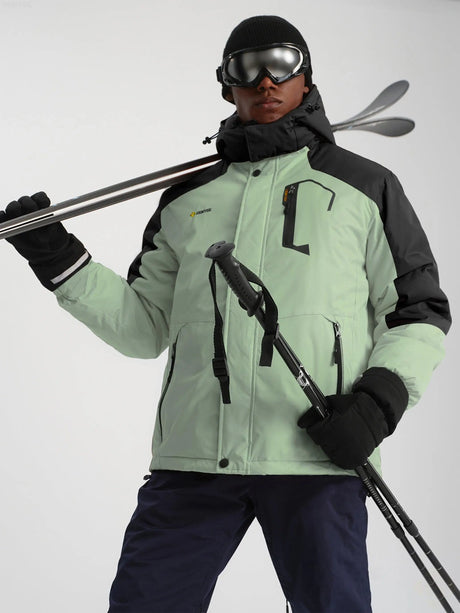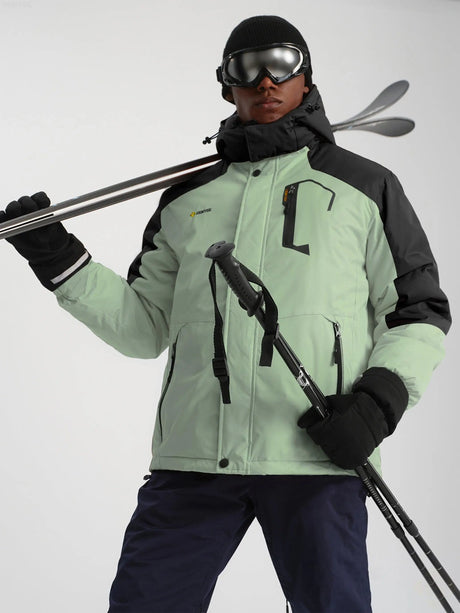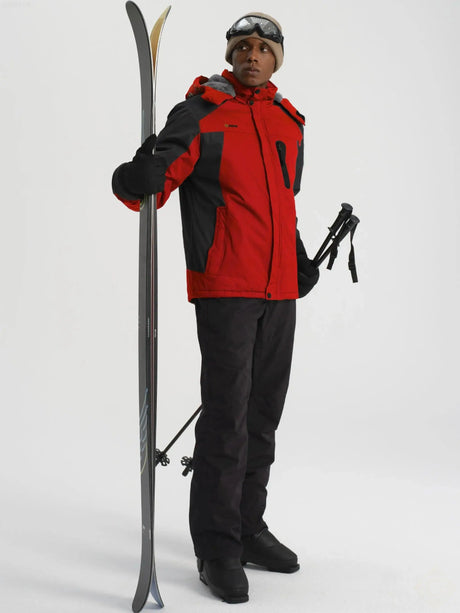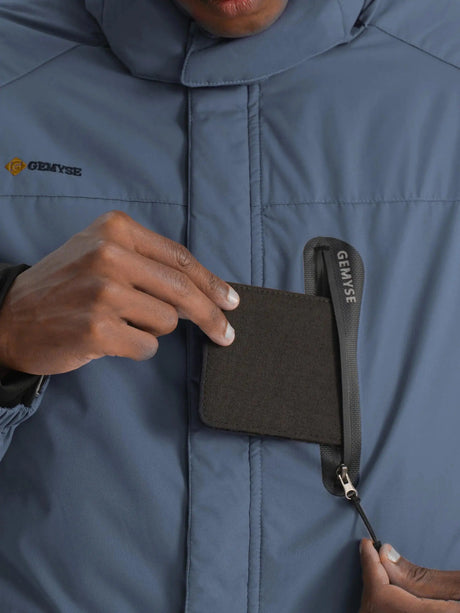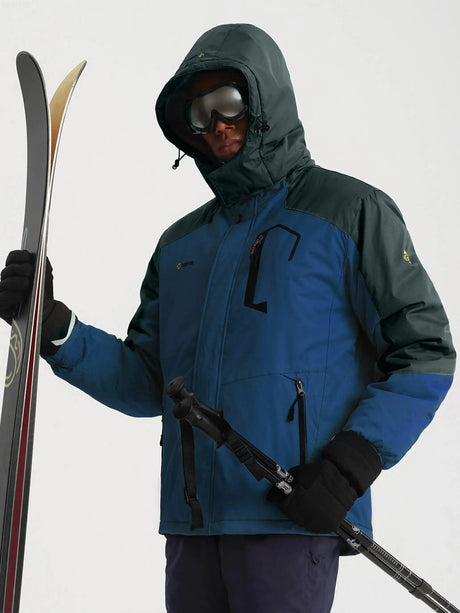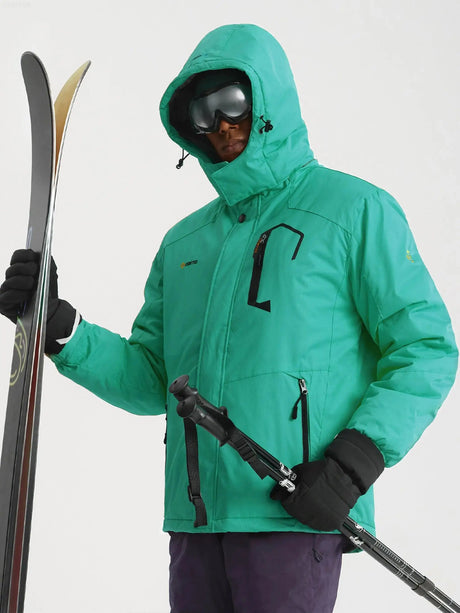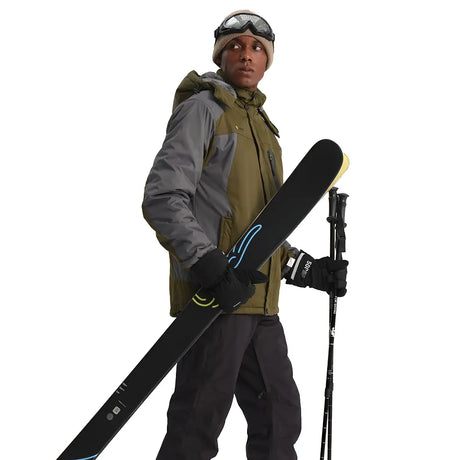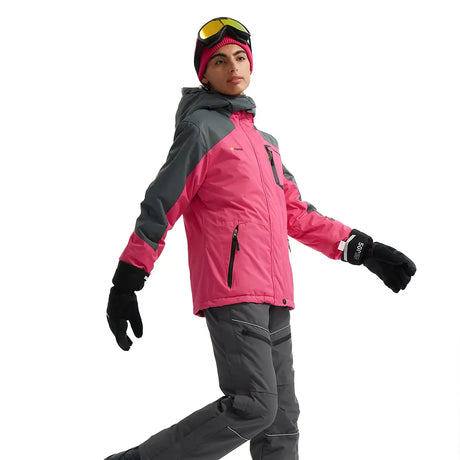best winter sports gear for beginners
Embarking on your first winter sports adventure is thrilling. The crisp air, snow-covered slopes, and the promise of fun await. But before you hit the slopes, you need the right gear.
Choosing the best winter sports gear is crucial for beginners. It ensures safety, comfort, and an enjoyable experience. Without the right equipment, your day on the slopes could be less than ideal.
For first-time skiers, understanding what to wear is key. The right clothing keeps you warm and dry. It also allows for freedom of movement, which is essential for learning.
Layering is a fundamental concept in winter sports. It helps regulate your body temperature. This is important as you transition from active skiing to resting.
Safety gear is non-negotiable. Helmets and goggles protect you from potential injuries. They also enhance your visibility and confidence on the slopes.
Renting equipment is a smart choice for beginners. It allows you to try different gear without a big investment. This can help you decide what to buy later.
Finally, remember that skiing is about having fun. With the right gear, you can focus on learning and enjoying the experience. So, gear up and get ready for an unforgettable adventure!
Why the Right Winter Sports Gear Matters for Beginners
Selecting the right winter sports gear is vital for beginners. This ensures safety and enhances your enjoyment. Proper gear makes your first experience more rewarding.
Beginners need gear that offers protection from the cold and harsh conditions. Your clothing must shield you from winds and moisture. This protection allows you to focus on learning, not discomfort.
Safety is a crucial aspect of winter sports. Wearing properly fitting helmets and goggles reduces injury risk. This gear gives beginners the confidence needed to tackle skiing challenges.
Having the correct equipment can boost performance. Well-chosen gear helps beginners learn the basics faster. This prevents needless setbacks and frustration.
Reasons Why the Right Gear Matters:
- Ensures comfort and protection from the elements
- Reduces risk of injury with protective gear
- Enhances learning by providing the right support
- Boosts confidence for tackling new challenges
Skiing is about enjoying nature and the outdoors. The right gear allows you to appreciate the beauty around you. This improves your overall skiing experience.
Understanding Ski Equipment Basics: What You Need to Get Started
Diving into skiing for the first time can feel overwhelming. Knowing the basics of ski equipment eases this transition. The right gear ensures a smoother learning curve.
First, let's discuss skis. Skis should match your height and skill level. Beginners benefit from shorter, softer flex skis. These skis are easier to control, promoting balance and confidence on the slopes.
Bindings are crucial components of ski gear. They connect boots to skis, enhancing control. Make sure your bindings are correctly set for your weight and ability. Incorrect settings can hinder your performance.
Ski poles are not just about rhythm. For beginners, they assist in balance and turns. Poles should be the correct length for your height. This helps you maintain proper posture while skiing.
Here's a basic list of must-have ski equipment:
- Skis: Shorter, softer-flex options are best for beginners.
- Bindings: Ensure proper settings for weight and experience.
- Ski Poles: Choose the correct length for balance and control.
Ski boots can make or break your skiing experience. They should fit snugly but allow for slight flexion. Consider renting to find the right fit before purchasing.
Here's a simple checklist for additional essentials:
- Helmet: Provides safety and warmth.
- Goggles: Essential for protecting eyes in snowy conditions.
- Gloves: Waterproof and insulated for comfort.
Renting gear can be a smart choice for beginners. Rental shops adjust equipment to suit your needs. This allows you to test various equipment before buying.
Understanding these basics helps you hit the slopes confidently. Grasping the essentials of ski gear gives you a head start. It's about setting a solid foundation for future skiing adventures.

Ski Clothing Essentials: What to Wear Skiing for the First Time
Choosing the right ski clothing is vital for comfort and warmth. As a beginner, prioritize layers to adapt to changing conditions. You want to focus on quality and functionality rather than style.
Start with a thermal base layer. It should be made of moisture-wicking material. This keeps you dry and warm by moving sweat away from your skin. Cotton should be avoided, as it tends to retain moisture.
Next, add an insulating mid-layer. Fleece or down jackets work well here. They trap heat while remaining lightweight and breathable. This layer allows you to adjust your warmth easily throughout the day.
A waterproof and windproof ski jacket tops off your layers. It shields you from snow and cold winds. Look for features like ventilation zippers and removable hoods for versatility. Such details offer customization according to weather conditions.
Here's a list of recommended ski clothing layers:
- Base Layer: Moisture-wicking thermal top and bottom
- Mid Layer: Fleece jacket or down vest
- Outer Layer: Waterproof ski jacket and pants
Insulated ski pants are just as critical. These pants keep your legs dry and warm. Their construction should withstand harsh elements like snow and wind. Adjustable waistbands can enhance comfort and fit.
Now, let’s discuss ski socks. Choose a pair that’s breathable and moisture-wicking. Warm socks prevent blisters and keep feet comfortable. Avoid thick socks, as they can reduce circulation in snug ski boots.
Don't overlook accessories such as gloves, hats, and neck gaiters. Insulated, waterproof gloves keep your hands warm. A fleece-lined hat or helmet liner keeps heat from escaping your head. Neck gaiters provide extra protection against chilly winds and snow.
Here are essential ski clothing accessories:
- Gloves: Waterproof and insulated
- Socks: Warm, breathable, and moisture-wicking
- Hat/Neck Gaiter: Insulated and wind-resistant


Finally, try on all your gear before hitting the slopes. Ensure comfortable movement and flexibility. Your focus should be on skiing, not adjusting clothing constantly.
Choosing the best ski clothing allows you to concentrate on the joy of skiing. Layering properly provides warmth, comfort, and confidence. These essentials are foundational to a successful first-time ski adventure.
Layering 101: How to Stay Warm and Comfortable on the Slopes
Layering is an art that helps skiers stay comfortable on the slopes. This technique involves wearing multiple layers, each with a specific function. It allows you to adjust to varying weather conditions throughout the day.
Start with the base layer, the foundation of your outfit. Look for thermal tops and bottoms crafted from synthetic fabrics. These materials wick moisture away from your body, keeping you dry. A damp base layer can quickly lead to chilling discomfort.
Next, add an insulating mid-layer. This layer's purpose is to trap body heat. Opt for materials like fleece or a lightweight down jacket. Both options provide warmth without adding bulk. The mid-layer acts as a thermal barrier against the cold.
Your outer layer must be both waterproof and breathable. A ski jacket with these attributes protects from snow and wind. Good ventilation is critical, helping regulate body temperature. This layer is your defense against the elements while skiing.
Essential Layers for Optimal Warmth:
- Base Layer: Moisture-wicking thermal tops and bottoms
- Mid Layer: Fleece or insulated jacket
- Outer Layer: Waterproof, breathable ski jacket
Accessorize appropriately to maximize warmth. A pair of thermal gloves is a must. Ensure they are insulated and waterproof to keep your hands warm. Hats or helmets trap heat and protect against the cold.
Neck coverage is another important aspect. Use neck gaiters or balaclavas to shield against wind and snow. They provide warmth without bulkiness. These small pieces can significantly boost comfort levels on cold days.
Accessory Checklist for Ski Layering:
- Gloves: Insulated and waterproof
- Headgear: Warm hat or helmet liner
- Neck Protection: Balaclava or neck gaiter

In conclusion, layering is about balancing protection and comfort. By wisely selecting each layer, skiers can prevent overheating or chilling. Adjust your clothing based on weather and personal comfort. Mastering layering can enhance your skiing experience by keeping you warm and comfortable all day.
Must-Have Ski Gear Checklist for Beginners
Starting your skiing journey requires the right gear. It ensures safety and maximizes enjoyment on the slopes. The list of essentials can seem extensive, but each piece has a purpose.
Firstly, invest in well-fitted ski boots. They are crucial for control and comfort while skiing. Ill-fitted boots can cause discomfort and impede performance. Proper fitting is essential, ensuring support and warmth.
Another vital piece of gear is ski bindings. These connect your boots to the skis, allowing for stability. It's important they are properly adjusted to your skill level. Binding settings affect your safety during falls.
You will need sturdy skis appropriate for beginners. These should be easy to turn, enhancing your learning curve. Consult with experts or rental shops to choose the right skis. This ensures a better skiing experience.
Essential Ski Gear for Beginners:
- Ski Boots: Properly fitted, comfortable, and supportive
- Ski Bindings: Securely adjusted to skill level
- Skis: Beginner-friendly, easy to turn
Don't forget about balance and rhythm. Ski poles provide both on the slopes. They should be lightweight yet durable. Choose poles that match your height and are easy to grip.
Safety is paramount, so a ski helmet is non-negotiable. It reduces injury risk on the slopes. Helmets should fit snugly and comfortably. Good ventilation also improves comfort during extended wear.
Additional Necessary Equipment:
- Ski Poles: Lightweight and easy to handle
- Helmet: Well-ventilated for protection and comfort

In summary, being well-equipped as a beginner skier involves careful selection. Prioritize items that enhance safety and ease of use. Familiarize yourself with the gear for a more confident skiing experience. With the right equipment, beginners can focus more on learning and fun.
Renting vs. Buying: What to Buy for Skiing as a Beginner
When gearing up for your first skiing trip, deciding whether to rent or buy equipment can be challenging. For beginners, renting is often the best choice. It allows you to try different gear and find what suits you best. Purchasing equipment right away can be a costly commitment. Renting also provides you access to the latest models without the upfront expense.
For those considering buying, start with basic essentials. A well-fitted ski helmet is a smart first purchase. It ensures safety and hygiene since you won't share it with others. Also, consider buying ski gloves and socks. These personal items contribute to comfort and warmth throughout your skiing day.
Renting skis, poles, and boots is practical for newcomers. Rental shops provide gear suited to your skill level and conditions. This flexibility helps you focus on learning and enjoying without worrying about poor equipment choices. Plus, rental staff can offer valuable advice on gear usage and adjustments.
Suggested Items to Buy:
- Ski Helmet: Personal safety and hygiene
- Ski Gloves: For warmth and comfort
- Ski Socks: Prevent blisters and keep feet warm
In summary, weigh the pros and cons when deciding to rent or buy. Renting offers flexibility and financial savings for beginners. Purchase personal items that enhance safety and comfort. As you progress, consider investing in your own gear. This ensures a more personalized and enjoyable skiing experience.

Safety First: Helmets, Goggles, and Protective Gear
When hitting the slopes, safety should be your top priority. Wearing the right protective gear can prevent injuries and enhance your skiing experience. Helmets are essential and should be well-fitted to provide maximum protection. They not only shield your head but also keep you warm on chilly days.
Goggles are another crucial piece of gear for beginners. They protect your eyes from harmful UV rays and improve visibility in snowy conditions. Ensure your goggles fit snugly with your helmet, covering your eyes entirely without gaps. Opt for lenses suited to the prevailing light conditions for optimal clarity.
Aside from helmets and goggles, consider additional protective gear. Wrist guards are helpful for beginners who might fall frequently. They provide support and protect against strains or fractures. Padded shorts can also cushion falls, making those inevitable tumbles less daunting.
Essential Protective Gear:
- Helmet: Protects head from impacts and cold
- Goggles: Shields eyes, enhances visibility
- Wrist Guards: Prevents injuries from falls
- Padded Shorts: Cushions impacts on falls
Investing in quality protective gear is an investment in your safety and skiing enjoyment. With the right equipment, you'll have peace of mind on the slopes. So suit up and focus on having fun and building your skills!

Accessories and Extras: Stuff You Need for a Great Day on the Slopes
Beyond the basics, some accessories can make your skiing experience even better. These extras add convenience and comfort to your time on the slopes. They are the little things that ensure you have a seamless and enjoyable day.
A sturdy backpack is useful for carrying essentials like water, snacks, and additional clothing. This means you'll have everything handy without frequent trips to the lodge. Hydration is vital at high altitudes, so a water bottle is a must.
Consider bringing hand warmers for those particularly cold days. They fit easily in your gloves or pockets to provide extra warmth. Don't forget sunscreen, as UV rays are stronger at altitude. A good lip balm will protect against chapped lips in the cold wind.
Handy Add-Ons:
- Backpack: Carries water, snacks, extra layers
- Water Bottle: Essential for hydration at altitude
Comfort Essentials:
- Hand Warmers: Provides extra warmth
- Sunscreen: Shields skin from UV damage
- Lip Balm: Prevents chapped lips
Finally, a small first aid kit is always a smart addition to your gear list. Be prepared for minor injuries by having bandages and ointments available. You'll be amazed at how these small items can enhance your skiing day.

Tips for Choosing the Best Ski Wear for Beginners
Selecting the right ski wear is crucial for beginners. The right clothing helps keep you warm and comfortable. It also allows you to focus on learning and enjoying the slopes.
Fit and functionality should top your list of priorities when choosing ski wear. Clothing that fits well will provide better movement and insulation. Look for items specifically designed for skiing, as they offer features like waterproofing and breathability.
Consider the importance of insulation. Good insulation keeps you warm without adding bulk. Light, insulated jackets and pants are ideal as they provide warmth and ease of movement. Make sure your ski wear includes moisture-wicking layers to keep sweat away from your skin.
Key Points for Choosing Ski Wear:
- Fit and Comfort: Ensures good movement
- Insulation: Keeps warmth in without added bulk
- Moisture-Wicking Layers: Keeps skin dry
When trying on ski wear, test for comfort in skiing positions. Bend and stretch to ensure there's no restriction. Comfort and functionality help beginners enjoy a successful skiing experience without distractions from ill-fitting attire.

Preparing for Your First Ski Trip: Packing and Planning
Planning your first ski trip can seem daunting. But, with the right preparation, it becomes an exciting adventure. Start by researching your destination and understanding its unique requirements, including weather conditions and terrain.
Your packing list is your best friend. It ensures you have everything you need, reducing the risk of forgetting essentials. Begin by listing your ski essentials: clothing, gear, and safety equipment. Consider the specific demands of your chosen ski resort, as some locations may have unique features or requirements.
Think about the extras that will enhance your experience. Items like sunscreen, lip balm, and snacks are often overlooked but can greatly impact your comfort on the slopes. Additionally, consider bringing a small daypack to carry essentials like water and an extra layer.
Packing Checklist:
- Ski Gear: Boots, poles, and bindings
- Clothing: Base layers, ski jacket, and pants
- Safety Equipment: Helmet and goggles
- Extras: Sunscreen, snacks, and ski map
Finally, plan your itinerary to include lessons or guided sessions. These can help you gain confidence and skills quickly. Preparing with a detailed checklist and plan can ease your mind, letting you focus on enjoying the slopes.

Common Mistakes Beginners Make (and How to Avoid Them)
Embarking on your first ski adventure is exciting, but it's easy to fall into common pitfalls. One frequent mistake is neglecting to layer properly. Skiing can leave you feeling both hot and cold, so balance is key. Overdressing or underdressing can lead to discomfort and distract from the experience.
Beginners often underestimate the importance of quality gear. Rental equipment, while convenient, can sometimes be worn or less effective. Ensure your gear fits well and meets your comfort and safety needs. Investing a bit more in well-maintained equipment can significantly enhance your experience.
Don't overlook slope safety and etiquette. New skiers might rush into more challenging runs too soon. This can be dangerous and discouraging. Always stick to beginner slopes until you gain more confidence. Safety should be your top priority; remember to:
- Start with easy slopes.
- Respect signage and trail markers.
- Know your limits and pace yourself.
By avoiding these common mistakes, you create a safer and more enjoyable skiing journey. Learn from others, prepare thoroughly, and take things at your own pace. With patience and careful planning, you can focus on the joy of skiing.
Final Thoughts: Enjoying Your First Winter Sports Adventure
Embarking on your first winter sports adventure is a milestone filled with excitement and anticipation. With the right preparation and equipment, it can be an unforgettable experience. Prioritize comfort and safety while learning the ropes of skiing or snowboarding.
Remember that every expert was once a beginner. Allow yourself time to adjust and learn at your own pace. Patience is crucial in the early stages, so don't be discouraged by initial challenges or slips on the slopes. Each run is a step closer to mastery and more confidence.
Finally, immerse yourself in the natural beauty of the winter landscape. Take moments to pause and appreciate the breathtaking vistas that these sports offer. Winter adventures are about more than just the thrill; they provide an opportunity to connect with nature and relish in outdoor splendor. Embrace the experience with an open mind and a spirit of adventure, knowing that every moment contributes to your newfound passion.

